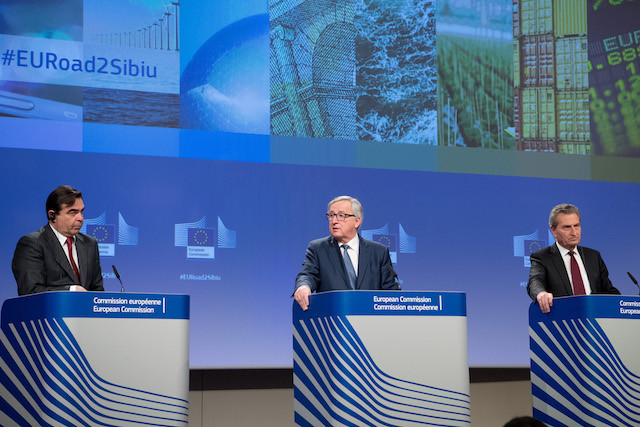Among the proposals are keeping the “Spitzenkandidaten” process for electing the European Commission president, but additionally calling on political parties to make the choice of the lead candidates earlier and to start the election campaign earlier. European parties should also adopt the logo of their affiliated European party group in national election campaigns. In a side dig, the Commission presentation urges France’s En Marche party to join one of the European groups in the European Parliament (EP).
These ideas and proposals are set to launch the debate within and among member states on reforming the EU without changing the treaties.
EP after Brexit
The commission’s press statement is cautious about the idea of creating transnational lists for the seats vacated by the UK in 2019. Not only would it require unanimity in the Council, but also changes to electoral laws in all 27 member states in the next year to be applied for the 2019 elections.
One head, two hats
Jean-Claude Juncker reiterated the idea of creating a single office for the president of the European Commission and the European Parliament. This would allow for more efficiency, increase visibility both within the member states and globally and would not imply merging the two institutions.
Citizens’ dialogues
The European Commission intends to continue its town hall meetings, called “citizens’ dialogues”, where members of the European Commission discuss policies with citizens and representatives of national or regional authorities. A previous example in Luxembourg was when the commission president Jean-Claude Juncker came to the university to talk to students. In total, almost 500 of these events have been organised since 2012. While the number of live webstreaming (750,000), social media impressions (31.4 million people) were very encouraging, only 88,0000 people actually participated. The European Commission intends to double that number to 1,000 over the next five years.
7-year budget
The current multiannual financial framework (MFF) covers the period of 2014 to 2020, and negotiations on the next one will start soon. The UK leaving will create a hole in the EU estimated at €15bn annually.
Currently, most of the budget goes into agriculture, rural development, fisheries and environment (€420bn), followed by “economic, social and territorial cohesion”, which includes areas like research and innovation, ICT, support for SMEs (€371.4bn), and competitiveness for growth and jobs (€142.1), where the money is spent on education, energy, and industry. However, despite member states’ commitments to develop and manage Europe’s borders better, the current budget for this policy only stands at €4bn over 7 years. The Commission presentation also throws up the question on whether structural funds (which provide funds to all members to invest in innovation, industrial transformation, or climate act) should be made conditional on the “respect for the EU’s fundamental values”, but should also consider the impact of any “possible breached of fundamental values or the rule of law at national level on the individual beneficiaries of EU funding, such as Erasmus students, researchers or civil society organisations.”
Common consolidated corporate tax base
The EU budget is financed by around 80% from national contributions based on gross national income and VAT. Some member states, such as the UK, have however negotiated rebates, and others got reduced VAT call rates (Germany, the Netherlands, Sweden) and other “compensation mechanisms to reduce budget contributions. The commission presentation stated that the current financing arrangement is “increasingly complex” and that “there is now a strong case for eliminating all such corrections.”
Several sources of revenue are being proposed: revenue collected on the emission trading scheme, revenue based on the common consolidated corporate tax base, “potentially combined with a digital component, or a harmonised VAT.” Another idea was that a “share of the income earned for the issuance of euros” could be funnelled to the EU budget.
